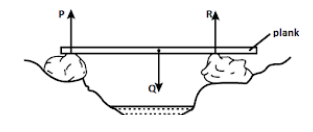
A wooden plank rests in equilibrium on two rocks on opposite sides of a narrow stream. Three forces $ P $ , $ Q $ and $ R $ act on the plank. How are the sizes of the force related?

(A)P + Q = R
(B)P + R = Q
(C)P = Q = R
(D)P = Q + R

Answer
524.1k+ views
Hint :In order to solve this question, we are going to first see that what will be the condition in order for the plank to be balanced over the two rocks and be in equilibrium. After that, the mathematical equation is written for that condition which gives the correct answer as required.
Formula used: In order for an object to be in equilibrium, it is necessary that the total force acting on it,
$ {F_{net}} = 0 $
Complete Step By Step Answer:
As it is given in the question that the wooden plank rests on the two rocks as we can also see in the above figure. Now, as the plank is in equilibrium, so, we know that, the total force on the plank in the upwards direction must be balanced by the total force on the plank in the downward direction,
Thus, we can also write that
$ Total\,upwards\,force = Total\,downwards\,force $
Now calculating the forces in the two directions as given, we get
$ P + R = Q $
Hence, the option $ (B)P + R = Q $ is the correct answer.
Note :
It is important to note that you might think that the forces $ P $ and $ R $ are opposite to the force $ Q $ , thus, in the mathematical expression, there must be a negative sign. But it is not necessary to put the negative signs as the directions for the vectors of the forces are already given in the figure that makes it understood.
Formula used: In order for an object to be in equilibrium, it is necessary that the total force acting on it,
$ {F_{net}} = 0 $
Complete Step By Step Answer:
As it is given in the question that the wooden plank rests on the two rocks as we can also see in the above figure. Now, as the plank is in equilibrium, so, we know that, the total force on the plank in the upwards direction must be balanced by the total force on the plank in the downward direction,
Thus, we can also write that
$ Total\,upwards\,force = Total\,downwards\,force $
Now calculating the forces in the two directions as given, we get
$ P + R = Q $
Hence, the option $ (B)P + R = Q $ is the correct answer.
Note :
It is important to note that you might think that the forces $ P $ and $ R $ are opposite to the force $ Q $ , thus, in the mathematical expression, there must be a negative sign. But it is not necessary to put the negative signs as the directions for the vectors of the forces are already given in the figure that makes it understood.
Recently Updated Pages
Why are manures considered better than fertilizers class 11 biology CBSE

Find the coordinates of the midpoint of the line segment class 11 maths CBSE

Distinguish between static friction limiting friction class 11 physics CBSE

The Chairman of the constituent Assembly was A Jawaharlal class 11 social science CBSE

The first National Commission on Labour NCL submitted class 11 social science CBSE

Number of all subshell of n + l 7 is A 4 B 5 C 6 D class 11 chemistry CBSE

Trending doubts
Differentiate between an exothermic and an endothermic class 11 chemistry CBSE

10 examples of friction in our daily life

One Metric ton is equal to kg A 10000 B 1000 C 100 class 11 physics CBSE

Difference Between Prokaryotic Cells and Eukaryotic Cells

1 Quintal is equal to a 110 kg b 10 kg c 100kg d 1000 class 11 physics CBSE

State the laws of reflection of light




